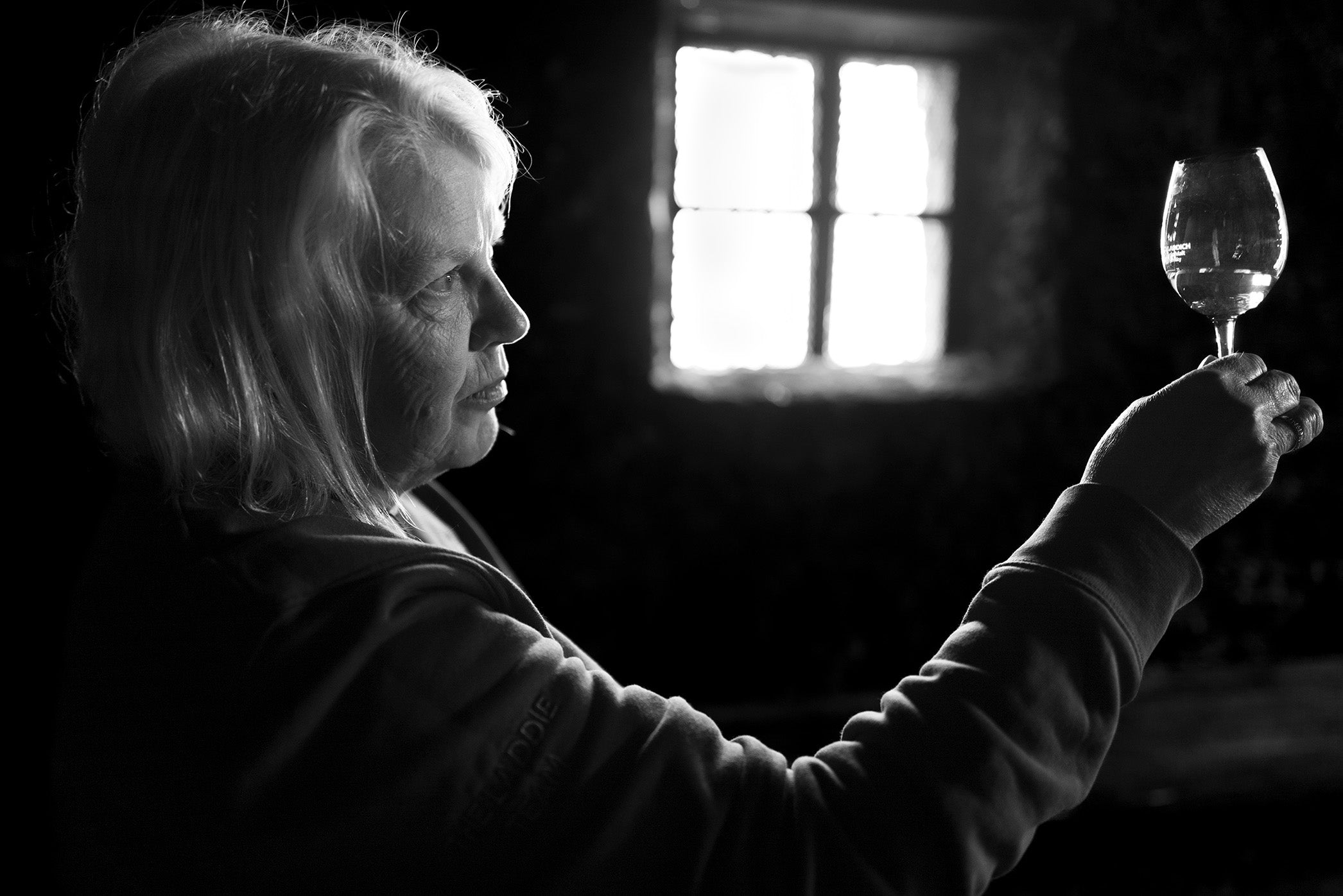A toast to the curious
- 12 mins
Join us as we take a peek into the history of experimentation in the whisky industry, what inspires it, and how our own super heavily peated, liquid icons of curiosity came to be.

Es sieht so aus, als ob Sie unsere Website von außerhalb Deutschlands besuchen.
Sie können zu unserer globalen Seite wechseln, um unsere Single Malts zu durchsuchen, aktuelle Veröffentlichungen online zu kaufen und in ausgewählte Länder und Orte weltweit zu liefern, die neuesten Nachrichten zu lesen und ein Konto zu erstellen.Join us as we take a peek into the history of experimentation in the whisky industry, what inspires it, and how our own super heavily peated, liquid icons of curiosity came to be.

They say necessity is the mother of invention. It could well be argued that such a proverb held more water in pre-industrial society, back when the needs were great and progression slow. Once the Industrial Revolution was well-established, invention became more a matter of convenience and efficiency, bending to the will of economies and politics rather than any great need. In the case of whisky, historically speaking, the type we drink has had more to do with politics than preferences.
Take for example, peat. From the very first record of whisky in the 15th century (then the new make spirit known as aqua vitea) up until the 1800s, peat would have been the primary fuel used for both the kilning of barley and distillation itself. In a series of inventions and economic changes, the face – and flavour – of the whisky industry was radically altered. The creation of the Coffey still and the arrival of rail lines that brought coal north were the impetus for change. As centralisation of production grew and blended Scotch boomed, peat took a backseat.
Efficiency became the name of the game in the industry. But for distillers to develop new, interesting experiences for the drinker, they need time: time to create, time to fail, and time to make adjustments. They also need the ability to take risks. Neither of these factors are acceptable when quantity and consistency are the driving forces. As demand for Scotch sky-rocketed through the late 20th century, creativity and her inspirateur, curiosity, were put out to pasture – at least so far as flavour was concerned.
Enter the 21st century, stage left.
Today, there’s significant pushback against industrialised, mass-produced goods. We like our shoes to come with a personal story, our travel itinerary bespoke, and our whisky with a bit more nuance. Experimentation is now intentionally pursued – sometimes simply as a tool to meet capitalism’s rapacious desire for something new and different (mango-flavoured beer, here’s lookin’ at you), but occasionally it’s born from genuine curiosity. Interestingly, we often find ourselves looking back in order to move forward.
It was relentless curiosity that motivated the reopening of Bruichladdich Distillery in 2001. Mark Reynier, Simon Coughlin, and Jim McEwan were driven to push the envelope and ask the questions that few had imagined. Their exploration began with terroir and the provenance of barley; their curiosity combed the soil and water systems of Islay, working with local farmers to support the island economy, and branched out with R&D in soil health, regional trials, and heritage grains.

As whisky writer Dave Broom said about Bruichladdich’s history of questioning and trialing new ways, “It’s not just working with local farmers...it’s bringing them onboard with regenerative farming, it’s taking the risk yourself...it’s looking at the different fuels. It’s all of these different aspects, you know—it’s the joined-up thinking.
“The good thing is that other people are now joining.”
Much of the experimentation we see today comes from a place of both need and curiosity: individuals and businesses are creating solutions that meaningfully contribute to the progress of our communities while simultaneously creating exceptional products. They’re exploring not just the what but also the how, why, and why not.
“That’s the ultimate point of it – you have to ask questions. As soon as you stop asking that kind of ‘Ooh...I wonder what would happen if I did this...’, then the industry dies,” says Broom.
That curiosity has played as much of a part in Bruichladdich’s progress as its commitment to its values. Perhaps the most iconic symbol of the distillery’s curiosity is Octomore. This range of super-heavily peated Scotch began as the best ideas usually do (with a “What If?”) in the place where most good ideas (and many bad ones) are born – the pub.

Not long after Bruichladdich had distilled its signature, unpeated spirit and the heavily peated Port Charlotte, former Head Distiller, Jim McEwan, and co-reviver of Bruichladdich Distillery, Mark Reynier, sat pondering over drams in the Port Charlotte Hotel. If at 40 PPM the elegance, finesse and purity of Bruichladdich spirit still shines through, what would happen if we upped the peat even further? Just how far could this be taken?
Jim and former Distillery Manager, Duncan McGillivray, decided to pay a visit to Bairds to learn more. This Inverness malting company provides malted barley to brewers and distillers around the globe. Bairds uses Saladin boxes in which the barley is steeped, germinated, and kilned all in the same box. Peat bricks are burned outside the box over the course of two to three days and the smoke is ducted through. The phenolic level is then measured in house. To produce a specific PPM level as requested by each distillery, Bairds then cuts the peated malt with an unpeated malt to achieve the exact phenolic level – as we do, for example, with Port Charlotte (40PPM).
But what if we used only peated barley to make a whisky? Would that even be drinkable? Has anyone ever done it?
It turns out that yes, it’s very drinkable if done right. And no, at that point no one had done that before with whisky. At least not in the previous 100+ years.
Bairds was initially reluctant, both because they didn’t have a large capacity for peating, but also because they couldn’t guarantee consistency in the peat level. But the Octomore idea is about experimentation and pushing the boundaries. Jim wasn’t bothered about consistency.
To allow the barley to absorb the maximum amount of peat smoke, Bairds exposes the barley for five days over lower heat. This, of course, slows production for Bairds and increases the cost, which explains why it’s not commonly requested. Once again, we see that time and risk are required to explore unknown territories.
Octomore fans may have noticed that the PPM vary dramatically in different Octomore releases, from 80 PPM (the minimum we require to make an Octomore) to over 300 PPM. This is because the amount of peat the barley absorbs depends on numerous factors, including the moisture content of the grains, the time spent exposed to peat smoke, and given that peat is a natural product, the amount and type of peat used. It’s also worth noting that the PPM level refers to the peat level of the barley and not that of the matured, bottled whisky. PPM levels fall through the process of distillation and maturation.
But the exploration didn’t stop there. The what-ifs continued, pushing Octomore to challenge more than just peat level. What if we use virgin oak? What if we only age it for five years? What if we bottle it at near cask strength? What if we use 100% Islay barley? Octomore is the impossible equation – it broke all the conventions of whisky-making: too young, too strong, too peated. It shouldn’t work. And yet it does.

I asked Master Blender Adam Hannett why it is that these unconventional factors actually work with Octomore. He explains that it all begins with the quality of the spirit. First, Bruichladdich works with high-quality Scottish grain. The process of mashing, the slow fermentation, the slow distillation which preserves a lot more of the natural oils...everything is focused on the quality of the spirit.
“We’re not searching for those high levels of peat, so we’re not adjusting the cuts to try to get more of the phenols,” he explains. “We’re distilling in a way that gives us the absolute best of the middle cut: keeping that nice long foreshot, allowing everything to settle. And then when we’re cutting into tails, we’re not allowing that to go a little bit further to start to recover more of the phenols. We’re just cutting where we know the quality of the spirit is good.”
It’s the same thinking with the casks. For Octomore, Adam chooses quality fresh casks – ones of high-quality wood that have only been used for bourbon or wine. Because the casks are fresh, the wood gives more to the spirit at a faster rate.
“It starts to challenge the idea of time and age being better. If you’ve made really good spirit – you’ve not gone searching for those phenols, and you’ve got that texture, that flavour, that viscosity – age doesn’t really matter. ”
The logic applies to the high strength, as well. “There’s less dilution, so you have a more concentrated flavour. If you’ve distilled well and you have a nice middle cut, then the alcohol is warming. It’s not aggressive. You can taste it, but it doesn’t burn all the way down. It’s an oily spirit with a really good mouthfeel, which works against the idea that the alcohol will be harsh.”
In other words, it’s all about quality and balance.
“I consider Octomore an exploration of single malt whisky,” says Adam. “Our PPM levels are a huge factor in the base layer of our flavour profile, but it doesn’t end there. We have always been interested in the nuance, and the detail, in pursuing flavour through variation; through age, distillation style and techniques, cask maturation, or bottling strength. With each release of Octomore, we declare several details that influence its flavour profile, the PPM of the malt when we started production is just one of these. To focus solely on the PPM number is to miss the point of Octomore entirely.”
In conventional theory, Octomore should not work. And indeed, it would not work if not for the questioning nature of the many who came before and the inventiveness of its protagonists – as well as their dedication to quality. It is only because the distillery allowed the time for experimentation and took risks that we have Octomore – as well as a passionate fan base to drink it. Its evolution, likewise, is dependent upon the relentless curiosity of those who continue to create it.
“Octomore came into being as a question, as a challenge, and an exploration of how we distil, and how we think about whisky.”
And here we are, on our sixteenth release of Octomore, still asking questions. So, join us in raising a glass to The Curious – to those who continue to ask ‘what if?’.

Bitte geben Sie Ihr Geburtsjahr ein
Standort
Um die Seite Bruichladdich.com zu besuchen, musst Du mindestens 18 Jahre alt sein. Beim Eintritt akzeptierst Du die Allgemeinen Geschäftsbedingungen sowie unsere Privacy Policy. Bitte genieße unsere Single Malts verantwortungsbewusst.
Um die Seite Bruichladdich.com zu besuchen, musst Du mindestens 18 Jahre alt sein. Beim Eintritt akzeptierst Du die Allgemeinen Geschäftsbedingungen sowie unsere Privacy Policy. Bitte genieße unsere Single Malts verantwortungsbewusst.
Um die Seite Bruichladdich.com zu besuchen, musst Du mindestens 18 Jahre alt sein. Beim Eintritt akzeptierst Du die Allgemeinen Geschäftsbedingungen sowie unsere Privacy Policy. Bitte genieße unsere Single Malts verantwortungsbewusst.
Um die Seite Bruichladdich.com zu besuchen, musst Du mindestens 18 Jahre alt sein. Beim Eintritt akzeptierst Du die Allgemeinen Geschäftsbedingungen sowie unsere Privacy Policy. Bitte genieße unsere Single Malts verantwortungsbewusst.
Um die Seite Bruichladdich.com zu besuchen, musst Du mindestens 18 Jahre alt sein. Beim Eintritt akzeptierst Du die Allgemeinen Geschäftsbedingungen sowie unsere Privacy Policy. Bitte genieße unsere Single Malts verantwortungsbewusst.